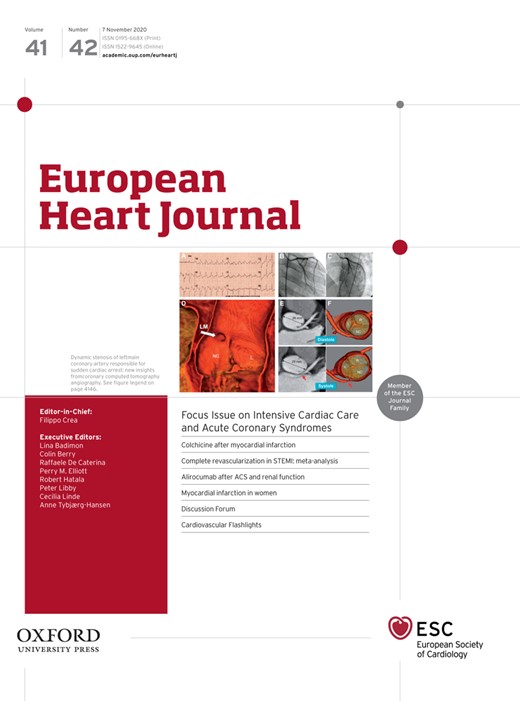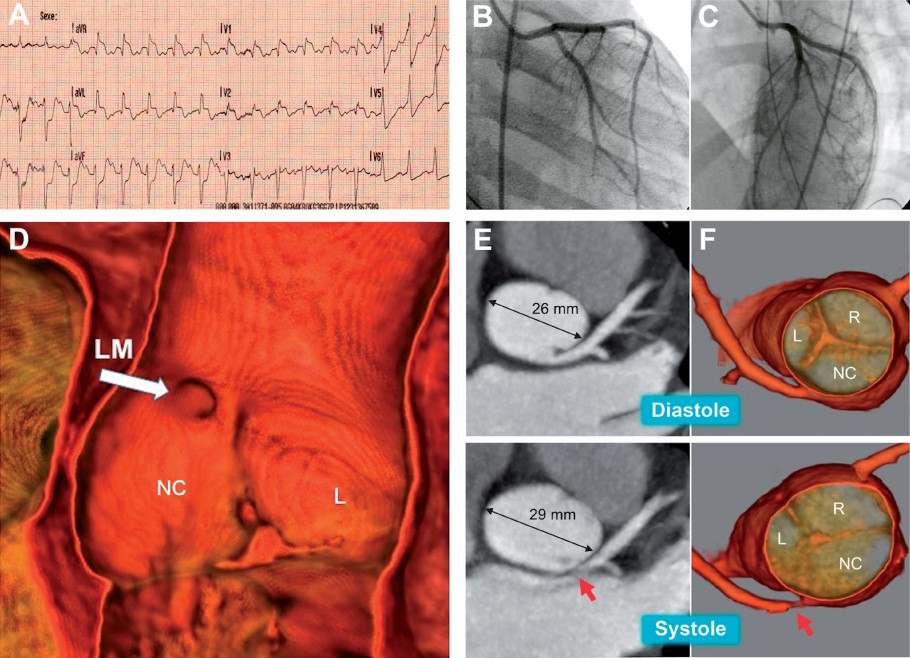
Volume 41, Issue 42
7 November 2020
Cover image

Cover image

Dynamic stenosis of left main coronary artery responsible for sudden cardiac arrest: new insights from coronary computed tomography angiography
Laetitia Neuvillers 1, Lisa Guirgis 2, Virginie Lambert 1, and Jean-François Paul 3*
1 Cardiology Department, Institut Mutualiste Montsouris, 42 Bd Jourdan, 7504, Paris, France; 2 Cardiopediatry Department, Hoˆ pital Marie Lannelongue, 92350, Le Plessis-Robinson, France; and 3 Radiology Department, Institut Mutualiste Montsouris, 42 Bd Jourdan, 7504, Paris, France
*Corresponding author. Tel: +33 1 56616057, Email: [email protected]
An 11-year-old boy with an unremarkable medical history collapsed during sports practice with cardiac arrest and was successfully resuscitated after immediate cardiac massage by his school teacher. The electrocardiogram (Panel A) showed anterior myocardial infarction with aVR ST-elevation. Coronary angiography (Panels B and C, Supplementary material online, S1) and ventriculography (Supplementary material online, S2) showed no coronary stenosis and antero-apical akinesia.
Coronary computed tomography (CT) showed that the origin of the left main coronary artery (LMCA) arose from the posterior sinus close to the left non-coronary commissure (Panel D), at the level of the sinotubular junction. Take-off was acute. Only mild stenosis was seen on the diastolic images (Panels E and F, top). However, end-systolic reconstructions showed severe systolic stenosis (Panels E and F, bottom). Coronary reimplantation surgery was recommended by the heart team as the only means of correcting this anomaly.
The exercise-induced ischaemia may be explained by several mechanisms, alone or in combination:
• The exercise-induced blood pressure increase, resulting in greater pressure on the aortic wall and therefore, potentially, in increased stenosis due to the acute take-off;
• Aortic root expansion due to the increased blood flow during systole (as shown in E, with a 3-mm increase in the long-axis diameter at the sinotubular junction), resulting in systolic stretching of the LMCA, with severe luminal narrowing (Panels E and F, bottom);
• The exercise-induced heart rate increase, with impaired blood flow during systole (due to the stenosis) and diastole (due to the short diastolic time).
This case underlines the importance of dynamic CT acquisition for comprehensive evaluation of anomalous coronary connections.
Supplementary material is available at European Heart Journal online.
ISSN 0195-668X
EISSN 1522-9645
Issue navigation
Volume 41, Issue 42, 7 November 2020
Focus Issue on Intensive Cardiac Care and Acute Coronary Syndromes
Issue @ A Glance
New challenges in the management of acute coronary syndromes: residual risk and sex-related inequalities
Filippo Crea
European Heart Journal, Volume 41, Issue 42, 7 November 2020, Pages 4075–4078, https://doi.org/10.1093/eurheartj/ehaa900
CardioPulse
Atherosclerotic Plaque Disruption and Healing
Rocco Vergallo and Filippo Crea
European Heart Journal, Volume 41, Issue 42, 7 November 2020, Pages 4079–4080, https://doi.org/10.1093/eurheartj/ehaa831
Research in the Antipodes at Green Lane
Harvey D White
European Heart Journal, Volume 41, Issue 42, 7 November 2020, Pages 4081–4084, https://doi.org/10.1093/eurheartj/ehaa303
Rheumatic heart disease and COVID-19
Andrea Beaton and others
European Heart Journal, Volume 41, Issue 42, 7 November 2020, Pages 4085–4086, https://doi.org/10.1093/eurheartj/ehaa660
PEARS procedure and the difficulty to provide evidence for its benefits
Christoph A Nienaber and others
European Heart Journal, Volume 41, Issue 42, 7 November 2020, Pages 4086–4088, https://doi.org/10.1093/eurheartj/ehaa596
Weekly Journal Scan
New hope for targeted treatment of obstructive hypertrophic cardiomyopathy: comment on the EXPLORER-HCM trial
Leonarda Galiuto and Carlo Patrono
European Heart Journal, Volume 41, Issue 42, 7 November 2020, Pages 4089–4090, https://doi.org/10.1093/eurheartj/ehaa801
Ubiquitous sex differences in tissue gene expression: the dawn of a new era for gender medicine
Giovanna Liuzzo and Leonarda Galiuto
European Heart Journal, Volume 41, Issue 42, 7 November 2020, Pages 4090–4091, https://doi.org/10.1093/eurheartj/ehaa877
Fast Track Congress
Intensive cardiac care and acute coronary syndromes
Time-to-treatment initiation of colchicine and cardiovascular outcomes after myocardial infarction in the Colchicine Cardiovascular Outcomes Trial (COLCOT)
Nadia Bouabdallaoui and others
European Heart Journal, Volume 41, Issue 42, 7 November 2020, Pages 4092–4099, https://doi.org/10.1093/eurheartj/ehaa659
Editorial
The sooner, the better: anti-inflammation in acute myocardial infarction
Thomas F Lüscher
European Heart Journal, Volume 41, Issue 42, 7 November 2020, Pages 4100–4102, https://doi.org/10.1093/eurheartj/ehaa752
Clinical Research
Intensive cardiac care and acute coronary syndromes
Complete revascularization reduces cardiovascular death in patients with ST-segment elevation myocardial infarction and multivessel disease: systematic review and meta-analysis of randomized clinical trials
Rita Pavasini and others
European Heart Journal, Volume 41, Issue 42, 7 November 2020, Pages 4103–4110, https://doi.org/10.1093/eurheartj/ehz896
Editorial
Managing patients with ST-elevation myocardial infarction and multivessel disease: is the story complete?
Jennifer A Rymer and Christopher B Granger
European Heart Journal, Volume 41, Issue 42, 7 November 2020, Pages 4111–4113, https://doi.org/10.1093/eurheartj/ehz956
Intensive cardiac care and acute coronary syndromes
Effect of alirocumab on major adverse cardiovascular events according to renal function in patients with a recent acute coronary syndrome: prespecified analysis from the ODYSSEY OUTCOMES randomized clinical trial
José Tuñón and others
European Heart Journal, Volume 41, Issue 42, 7 November 2020, Pages 4114–4123, https://doi.org/10.1093/eurheartj/ehaa498
Editorial
Chronic kidney disease: a high-risk group that deserves intensive lipid lowering
Christopher P Cannon
European Heart Journal, Volume 41, Issue 42, 7 November 2020, Pages 4124–4126, https://doi.org/10.1093/eurheartj/ehaa550
Intensive cardiac care and acute coronary syndromes
Women who experience a myocardial infarction at a young age have worse outcomes compared with men: the Mass General Brigham YOUNG-MI registry
Ersilia M DeFilippis and others
European Heart Journal, Volume 41, Issue 42, 7 November 2020, Pages 4127–4137, https://doi.org/10.1093/eurheartj/ehaa662
Editorial
Sex differences among young individuals with myocardial infarction
Marysia S Tweet
European Heart Journal, Volume 41, Issue 42, 7 November 2020, Pages 4138–4140, https://doi.org/10.1093/eurheartj/ehaa682
Discussion Forum
STEMI in COVID-19 patients: thrombolysis-first approach could yield more risk than benefit
Dimitrios A Vrachatis and others
European Heart Journal, Volume 41, Issue 42, 7 November 2020, Pages 4141–4142, https://doi.org/10.1093/eurheartj/ehaa477
Compromised STEMI reperfusion strategy in the era of COVID-19 pandemic: pros and cons
Lin Zhang and others
European Heart Journal, Volume 41, Issue 42, 7 November 2020, Page 4143, https://doi.org/10.1093/eurheartj/ehaa744
Cardiovascular Flashlight
Concomitant right coronary aneurysm and total occlusion of left anterior descending artery and left circumflex artery
Guoliang Li and others
European Heart Journal, Volume 41, Issue 42, 7 November 2020, Page 4144, https://doi.org/10.1093/eurheartj/ehaa746
Myocardial infarction with non-obstructive coronary artery revealing a heart tumour
Laetitia Neuvillers and others
European Heart Journal, Volume 41, Issue 42, 7 November 2020, Page 4145, https://doi.org/10.1093/eurheartj/ehaa815
Dynamic stenosis of left main coronary artery responsible for sudden cardiac arrest: new insights from coronary computed tomography angiography
Laetitia Neuvillers and others
European Heart Journal, Volume 41, Issue 42, 7 November 2020, Page 4146, https://doi.org/10.1093/eurheartj/ehaa429
Is anomalous right coronary artery from the pulmonary artery always innocent?
Ioannis Polymerou and others
European Heart Journal, Volume 41, Issue 42, 7 November 2020, Page 4147, https://doi.org/10.1093/eurheartj/ehaa540
Advertisement intended for healthcare professionals
Advertisement intended for healthcare professionals





